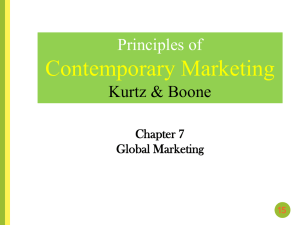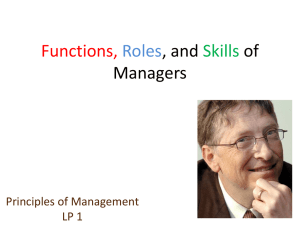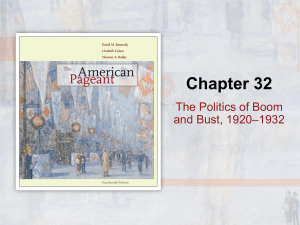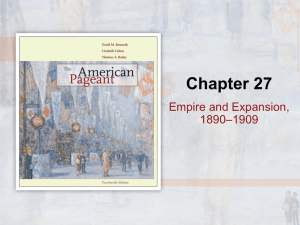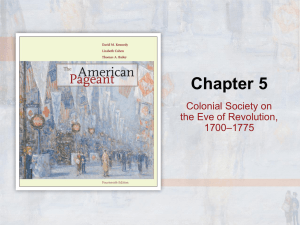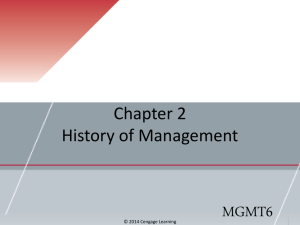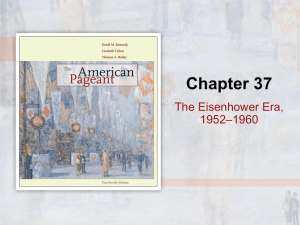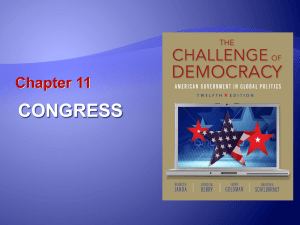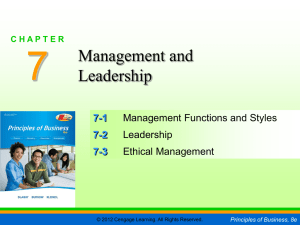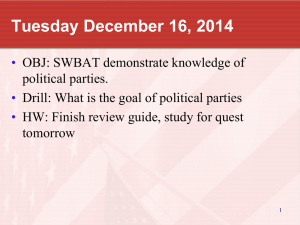Presidency PP
advertisement
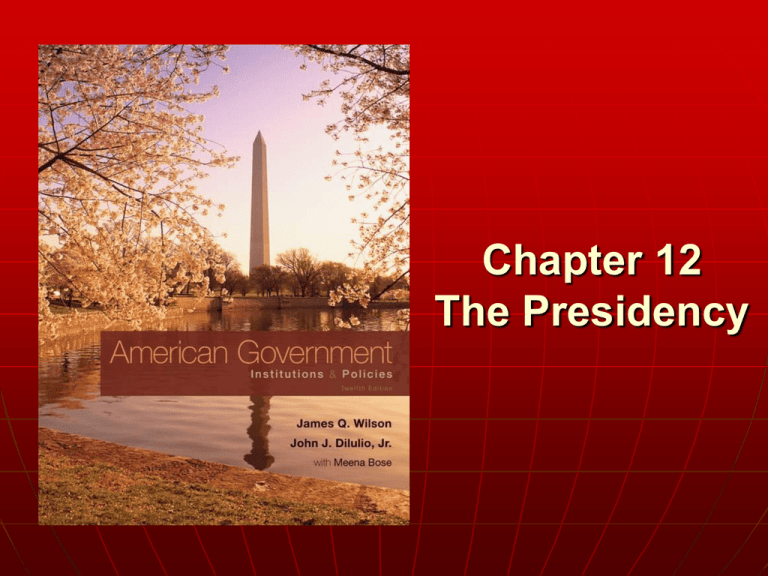
Chapter 12 The Presidency WHO GOVERNS? 1. Did the Founders expect the presidency to be the most important political institution? 2. How important is the president’s character in determining how he governs? TO WHAT ENDS? 1. Should we abolish the electoral college? 2. Is it harder to govern when the presidency and the Congress are controlled by different political parties? Copyright © 2011 Cengage Presidents and Prime Ministers Presidents are Often Outsiders Presidents Choose Cabinet Members from Outside Congress Presidents Have No Guaranteed Majority in Congress Copyright © 2011 Cengage The first cabinet: left to right, Secretary of War Henry Knox, Secretary of State Thomas Jefferson, Attorney General Edmund Randolph, Secretary of the Treasury Alexander Hamilton, and President George Washington. p. 360 Bettmann/Corbis Copyright © 2011 Cengage Divided Government Divided government – One party controls the White House and another party controls one or both houses of Congress Unified government – The same party controls the White House and both houses of Congress Does gridlock matter? Is policy gridlock bad? Copyright © 2011 Cengage Copyright © 2011 Cengage The Evolution of the Presidency Concerns of the Founders The Electoral College The President’s Term of Office The First Presidents The Jacksonians The Re-emergence of Congress Copyright © 2011 Cengage America witnessed peaceful transfers of power not only between leaders of different parties (such as Woodrow Wilson and William Howard Taft in 1913), but also after a popular leader was assassinated (Lyndon Johnson is sworn in after John F. Kennedy’s death). p. 366 Library of Congress Cecil Stoughton/White House/AP Photo Copyright © 2011 Cengage The Powers of the President Mark Wilson/Getty Images News/Getty Images A military officer carrying “the football” – the briefcase containing the secret codes the president can use to launch a nuclear attack. p. 370 Powers of the President Alone Powers the President Shares with the Senate Powers the President Shares with Congress as a Whole Copyright © 2011 Cengage The Office of the President The White House Office • Pyramid structure • Circular structure • Ad hoc structure The Executive Office of the President The Cabinet Independent Agencies, Commissions, and Judgeships Copyright © 2011 Cengage Source: Statistical Abstract of the United States, 2009, table 481. Copyright © 2011 Cengage Who Gets Appointed Prior federal experience “In-and-outers” Political following Expertise/ administrative experience Copyright © 2011 Cengage Secretary of Labor Frances Perkins (left), appointed by President Franklin Roosevelt, was the first woman cabinet member. Bettmann/CORBIS When Condoleezza Rice was selected by President George W. Bush to be National Security Advisor, she became the first woman to hold that position (and later the first African American woman to be Secretary of State). p. 378 Bob Daemmrich/PhotoEdit Copyright © 2011 Cengage Presidential Character Dwight Eisenhower John Kennedy Lyndon Johnson Richard Nixon Gerald Ford Jimmy Carter Ronald Reagan George H. W. Bush Bill Clinton George W. Bush Barack Obama Copyright © 2011 Cengage The Power to Persuade The Three Audiences • Fellow politicians and leaders • Partisan grassroots • The public Popularity and Influence The Decline in Popularity Copyright © 2011 Cengage Alex Wong/Getty Images President Bush shakes hands with Speaker Nancy Pelosi after his State of the Union address. p. 380 Sources: Updated from Congressional Quarterly, Guide to U.S. Elections, 928; and Congress and the Nation, vol. 4 (1973– 1976), 28. Copyright © 2011 Cengage Figure 14.2 Presidential Victories on Votes in Congress, 1953–2006 Note: Percentages indicate number of congressional votes supporting the president divided by the total number of votes on which the president has taken a position. Sources: Congressional Quarterly Almanac (Washington, D.C.: Congressional Quarterly, various years); Congressional Quarterly Weekly Report (CQ Weekly) (1992), 3894; (1993), 3473; (1994), 3620; (1996), 3428; (1998), 14; (1999), 76, 2972; (2001) 54; (2002), 142, 3237; (2004), 54–55, 2947–2948; (2006), 87; (2007), 50. Copyright © 2011 Cengage The Power to Say No Veto • Veto message • Pocket veto • Line-item veto Executive Privilege Impoundment of Funds Signing Statements Copyright © 2011 Cengage Source: Norman J. Ornstein, Thomas E. Mann, and Michael J. Malbin, Vital Statistics on Congress, 2001– 2002 (Washington, D.C.: Congressional Quarterly Press, 2001), 207 (updated). Copyright © 2011 Cengage Source: Norman J. Ornstein, Thomas E. Mann, and Michael J. Malbin, Vital Statistics on Congress, 2002–2003 (Washington, D.C.: Congressional Quarterly Press, 2003), 207 (updated). Copyright © 2011 Cengage Copyright © 2011 Cengage The President’s Program Putting Together a Program • Interest groups • Aides and campaign advisers • Federal bureaus and agencies • Outside, academic, other specialists and experts Attempts to Reorganize Copyright © 2011 Cengage Scherl/SV-Bilderdeinst/The image Works A group of Civilian Conservation Corps workers hired by the government during the Great Depression. p. 390 Copyright © 2011 Cengage Presidential Transition Michael Evans/The White House The Vice President Problems of Succession Impeachment Lame duck President Reagan, moments before he was shot on March 30, 1981, by a would-be assassin. The Twenty-fifth Amendment solves the problem of presidential disability by providing for an orderly transfer of power to the vice president. p. 392 Copyright © 2011 Cengage WHAT WOULD YOU DO? MEMORANDUM To: Delegate James Nagle From: Amy Wilson, legal staff Subject: Six-year presidential term The proposal to give the president a single six-year term is perhaps the most popular amendment now before the convention. Polls suggest that it is supported by a sizable percentage of the American people. Copyright © 2011 Cengage WHAT WOULD YOU DO? Arguments for: 1. Today, a president no sooner learns the ropes after being elected for the first time than he or she has to start preparing for the next election. A six-year term will give the president a chance to govern for several years after learning how to be president. This will lessen the extent to which political pressures dictate what the president does. 2. Limited to a single term, the president need not cater to special-interest groups or the media in deciding on policy. He or she can concentrate on what is good for the country. 3. Many states have limited their governors to a single term. Copyright © 2011 Cengage WHAT WOULD YOU DO? Arguments against: 1. It is the need to win reelection that keeps the president (like any politician) attentive to what the people want. A president unable to succeed himself or herself will be tempted to ignore public opinion. 2. Limiting a president to a single term will not free him or her from the need to play to the media or special-interest groups, since the formal powers of the presidency are too weak to permit the incumbent to govern without the aid of Congress and the press. 3. There is no evidence that presidents (such as Dwight Eisenhower) who served a second term knowing that they could not run for reelection did a better or less “political” job in the second term than in the first. Copyright © 2011 Cengage WHAT WOULD YOU DO? Your decision: Favor amendment? Oppose amendment? Copyright © 2011 Cengage How Powerful is the President? Presidential rules of thumb for dealing with political problems: • Move it or lose it. • Avoid details. • Cabinets don’t get much accomplished; people do. Copyright © 2011 Cengage Susan Walsh/AP Photo Barack Obama is sworn in as the 44th president. p. 396
